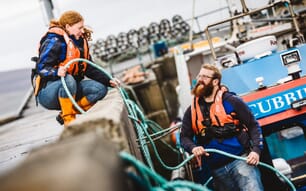The findings come just as the European Union considers controversial new legislation to manage deep-sea fisheries, including a ban on trawling below 600 metres.
"The most notable thing to consider about our findings is that the trend in catch composition over the depth range of 600 to 800 metres shows that collateral ecological impacts are significantly increasing while the commercial gain per unit effort is decreasing," said Joanne Clarke of the University of Glasgow.
In other words, "going deeper causes greater and greater damage for a reducing benefit to fishermen."
Studies have already shown that deep-sea fish species are more vulnerable, due to the fact that individuals tend to live for a long time while having relatively few offspring in comparison to shallow-water species.
Evidence has also shown that deep-sea bottom trawling has taken its toll, with implications for the deep-sea ecosystem and for the climate. Deep-sea fish sequester large amounts of carbon per year.
The question, Ms Clarke said, was: "Why a depth limit, and what depth?"
Study authors David Bailey of the University of Glasgow and Francis Neat of Marine Scotland Science came up with a way to find out by looking at changes in catch composition trends with depth.
The researchers collected data from trawl surveys between the depths of 240 and 1,500 metres in the northeast Atlantic. Those surveys used different gear types at various locations between 1978 and 2013.
An analysis of those data revealed a clear transition in catches at depths of 600 to 800 meters, including a significant increase in biodiversity, the ratio of discarded to commercial biomass, and the ratio of sharks and rays to commercial biomass. As the ecological impacts increased, the commercial value per unit of effort decreased.
"Depth limitations are often labelled as a 'blanket' measure, unsophisticated and poorly thought out," Ms Clarke said. "In this case, however, it appears that there would be some very specific conservation benefits to a depth limit at around 600 meters."
The discovery that their evidence backed the latest depth-limit proposal came as a surprise to the researchers.
"We had no prior reason to expect that our findings would suggest that this was in fact an appropriate depth," Ms Clarke said.
"We went into this analysis purely to test whether any depth appeared particularly suitable for a depth limit, but with no expectation that this would be the case."
The study findings, however, are not supported by fishery groups and organisations which say the report fails to understand the nature of commercial fisheries.
Commenting upon the study, Bertie Armstrong, chief executive of the Scottish Fishermen’s Federation, said: “Whilst the number of Scottish boats working a deepwater fishery is small, they do nonetheless make a significant contribution to the economies of local communities, catching and landing only the limited and sustainable quotas allocated.
“We have a number of concerns about the robustness of this research in terms of the real world of deep-sea fisheries. Using scientific survey data to draw conclusions upon commercial fishing activity is fraught with danger. This is because such information is normally collected via random trawl sampling, whereas commercial fishing tows are very targeted and aimed at specific species or groups of species.
“Commercial boats also use much more selective nets with larger meshes compared to those used in scientific sampling. Such trawls used by our fishermen will become even more selective in future years so as to meet the requirements of the discard ban, further minimising any impact.
“Therefore, given the nature of our deep water fishery and the fishing techniques used, there is absolutely no conservation benefit for a blanket closure beyond 600m depth – all it would do is displace boats to fish in other sea areas. Much better to have sensible management in these areas to ensure environmental protection whilst at the same time enabling the continuation of sustainable fishing.”
Similarly, Kathryn Stack, Managing Director of Europêche, commented: "Commercial trawling targets specific commercial species in known locations where catches are good. Bycatch is a nuisance and costly to fishing businesses so naturally fishermen try to avoid it. On the other hand, scientific surveys are located randomly and are aimed at measuring the abundance of a wide range of species in the sea and so certainly do not reflect the pattern of commercial activity. It is also important to bear in mind that the landing obligation will force vessels to be more selective since all catches will have to be landed. Vessels therefore will be avoiding areas where they would have directed efforts on these species."
European Council discussions on the matter are expected to begin again in September and, while there are many other factors at play, the researchers say they are "very confident that the work will be brought to the attention of the relevant people and at a critical time."




